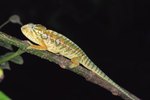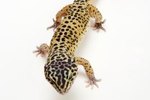
The gender of some reptiles like leopard geckos (Eublepharis macularius), crocodilians and tortoises is determined by the temperature at which the eggs incubate. Eggs incubated above a species specific temperature threshold become males, and eggs incubated at temperatures below this threshold become females. Anoles are different; their gender is determined genetically, like it is in snakes, birds and humans. This means that the gender of an anole is determined very early in the development process, relative to animals with temperature determined sex.
Size
Anoles are sexually dimorphic: Males and females attain different sizes. Juvenile lizards that haven’t yet developed secondary sexual characteristics will be similar sizes, but adult males are significantly larger than females are. Any anoles that approach the maximum length for the species -- 3 inches or so -- can be identified as males. Females top out at 1.5 inches or a little more. Smaller individuals can’t be reliably differentiated this way, and may be young males or females.
Dewlap
The male anole has a thin flap of extensible skin under the throat termed a dewlap. He extends it for territorial and mating purposes during a choreographed routine of pushups and head-bobs. The dewlap is brightly colored in most species, though one subspecies of the green anole (Anolis carolinensis seminolus) has evolved pale white or grey dewlaps. Though the occasional female has a rudimentary dewlap -- only the male has the well-developed, brightly colored dewlap.
Hemipenal Bulges
All male squamates – an evolutionary lineage including all living snakes and lizards – have paired reproductive organs termed hemipenes. The hemipenes are normally held inside the body creating two tail bulges; they evert only for mating purposes. When you inspect the ventral side of the tail, right behind the animal’s vent, the hemipenal bulges should be visible on a mature male. If no bulges are visible, the animal is either immature or female.
Behavior
Captive male anoles may engage in territorial displays, even housed alone. If an anole climbs to a perch, extends its dewlap and bobs its head; he's indeed a male. In large captive colonies, males may combat with each other, which may escalate to include biting. While females may become territorial, fighting among females is rare and is never as dramatic as fights between males.
Crest
Some species' males, though not all, develop dorsal crests along the top of their back. These structures help the males to look larger when battling or intimidating rivals. Though they are not present on all males, their presence of one is indicative of a male
Eggs
Anoles can store sperm for at least seven months. Accordingly, a wild-caught female may lay eggs for some time after capture. If your anole lays eggs; it is a female.
Head Size and Shape
In most species, male anoles have larger heads than the females do. According to a 2013 study by Thomas J. Sanger et al., published in "Evolution," some males are not only larger but they are shaped differently as well. Sanger and his team compared skulls of 50 species of anoles and found that the males of two evolutionary groups of anoles -- including the green anole's clade -- exhibited extremely long faces.
References
Photo Credits
-
Jupiterimages/Photos.com/Getty Images




